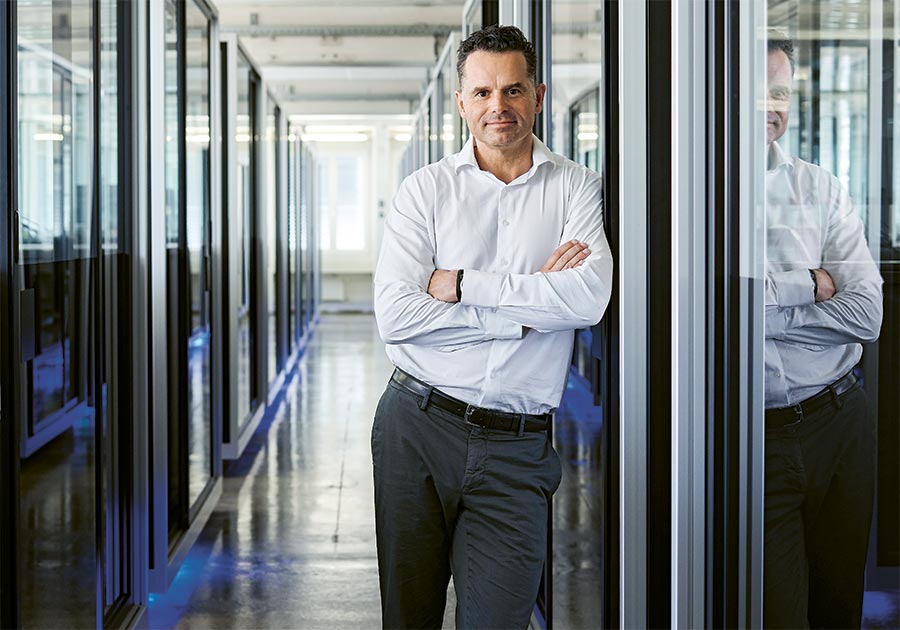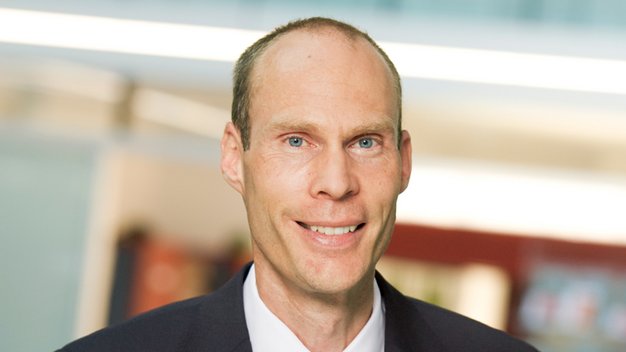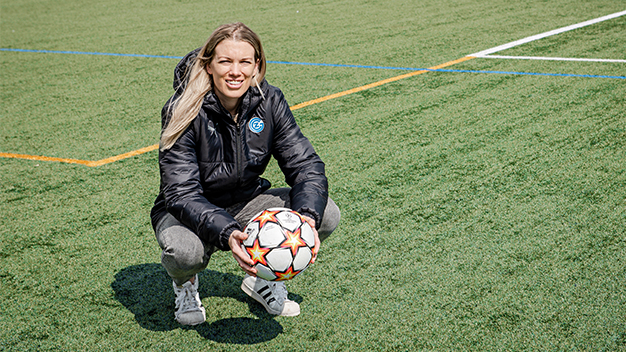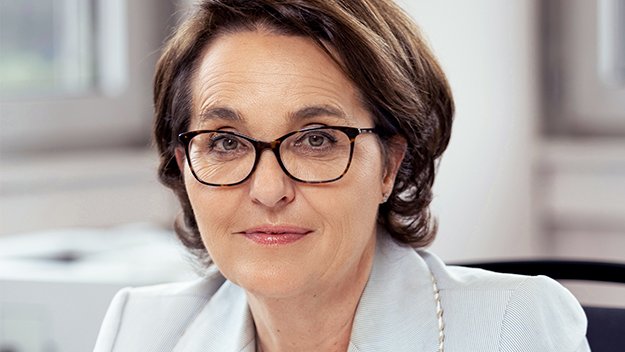Text: Editorial staff “ceo” | Images: Markus Bertschi | Magazine: Trust in the Digital Age – December 2017
#Swiss_engineering #automation_is_king #global_footprint
Martin Bosshardt, CEO of Open Systems in Zurich, ensures the inviolability of his customers’ IT infrastructure. In doing so, he relies on the know-how of nerds and the tenacity of “bots”. Despite the virulent threat constantly posed by hackers and viruses, this ETH engineer is convinced that spreading fear is no way to boost the public’s trust in the digital domain.
Glass walls scattered throughout the converted factory hall make for transparency. Behind a ceiling-high pane hangs a supersized map of the world. Luminous dots and a display with rapidly changing numbers indicate where and how much intervention is required at the moment. Staring intently at their monitors on the other side of the pane, two young technicians are at work – they, too, encased in a glass cubicle.
The “mission control centre” at Open Systems needs no massive walls, no video surveillance or doors secured with alarm systems. Here, insight and a new perspective into the surveillance work is afforded: the company has long since freed itself from the paranoia that otherwise pervades the digital security industry.
“In our business, transparency is a fundamental factor,” Martin Bosshardt emphasises. For the CEO of this Zurich-based enterprise system security firm, the glass walls – just as much as the choice of words – are part and parcel of building trust in this complex technology. “Our customers should be in a position to conduct their activities angst-free,” says Bosshardt.
Martin Bosshardt, born in 1968, is CEO of Open Systems Ltd. The company is headquartered in Zurich and has subsidiaries in New York and Sydney. Martin Bosshardt studied electrical engineering at the ETH. Before joining Open Systems, he worked for ABB and Young & Rubicam. A father of two sons, he is married and lives in Canton Zurich.
The task of the specialists at Open Systems is to keep a tight grip on risks and, if necessary, take remedial action without delay. Transparency in this regard also means seeing to it that everyone concerned can understand via “audit trails” where vulnerabilities have been identified in the systems and how the control mechanisms deal with the situation – 24/7/365.
“Technology alone doesn’t differentiate us from the competition; rather, it’s our people and the ways and means they apply in putting that technology to work,” notes the 49-year-old ETH engineering graduate who meanwhile has headed manufacturer- and provider-independent Open Systems for 15 years now. Founded in 1990, the firm supports a wide range of internationally active companies – a customer base that encompasses 180 countries and almost one million users – in questions concerning the security, performance and monitoring of IT networks, infrastructure and applications.
“Hack attacks on the infrastructure of our customers are conducted with belligerent criminal intent.”
“Hack attacks on the infrastructure of our customers are conducted with belligerent criminal intent,” says Bosshardt. Data theft, concerted actions aimed at debilitating various applications, and the spreading of viruses or malware are just the tip of the iceberg. The “WannaCry” attack this past May – which crippled computers in more than 150 countries, including those at vital facilities such as hospitals – demonstrates the order of magnitude of these risks.
And of course today’s dependency on computer technology exposes users to more vulnerabilities than ever before. At globally positioned companies, dozens of different operating systems are at work and the number of applications in use at these decentralised networks frequently goes into the hundreds, as Bosshardt knows all too well. At the same time, the capacity of the systems is increasing exponentially. “We develop software that helps other software to run without interference,” he points out. The goal here is to automate the protective mechanisms to the greatest extent possible. Four out of five incidents can be resolved by injecting bots into the system.
Open Systems Ltd, an independent provider of security solutions for corporate IT infrastructure, is headquartered in Zurich and has subsidiaries in New York and Sydney. More than 150 highly qualified employees support their customers with 24/7/365 service. That Zurich became the company’s central command site was a stroke of good fortune, according to the CEO. The proximity to universities and the headquarters of many global enterprises from the manufacturing and financial sectors helped the company to obtain important references during its initial growth phase. In 2011, Open Systems was named “Company of the Year” by the Swiss Venture Club. In June 2017, Swedish financial investor EQT Partners (via one of its funds) acquired a majority shareholding in the company.
www.open.ch
Bosshardt, who majored in electrical engineering at the ETH, likes to draw a comparison between IT infrastructure and electric power generation and distribution – both are of fundamental importance to the functioning of the global economy as we know it. If the systems identify a critical error, the first thing to do is to keep calm and open up an emergency access door. “If necessary, the applications are shut down briefly until the breach is sealed or the damage repaired,” Bosshardt explains. As a rule, a task force is formed to assess the situation and then identify the “fingerprint” of the attack.
It is absolutely necessary in cases like this that lines of communication with the customer are open and being intensively used. “We render a service that our customers cannot afford on their own,” says the CEO. More than anything else, it takes openness and transparency to demonstrate that fact – which is another reason for the glass walls at the company’s headquarters.
“In our business, transparency is a fundamental factor: our customers should be in a position to conduct their activities angst-free.”
Martin Bosshardt
Short questions – short answers
What’s your favourite app?
Spark – it’s an app that sorts my e-mails in an intelligent way.
Can you remember the first cell phone you ever had? Which model was it?
A Motorola StarTAC – the first flip-phone.
What do you have as a background on your smartphone or laptop?
A pine-panelled wall that reminds me of our holiday home in the Alps.
When you consider the notion of “Trust”, which keywords come to mind?
Integrity, loyalty and authenticity.
“Doveryai, no proveryai”, as Ronald Reagan told Mikhail Gorbachev at the time – “Trust, but verify”. How does that fit together?
Our business is extremely complex. It requires an unbelievable level of expertise and therefore unwavering trust that our people have a mastery of the tasks they’ve been assigned and fully understand the related problems. Also important – and we do our best to foster it – is a corporate culture that is based on trust and mutual esteem. This crystallises in one’s choice of words or in the way one supervises, as well as in the form of the control mechanisms that are implemented.
You work with highly intricate technologies. Can one actually rely on them?
Gaining trust in machines is a step-by-step process. Ultimately, it is man who plays the key role also in this regard. Humans are the ones who make technology possible and manageable in the first place.





